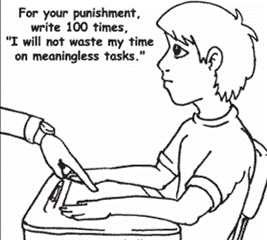"If you fail to plan, you plan to fail."
"Effective teachers introduce rules, procedures, and routines on the very first day of school and continue to teach them the first week of school."
The teacher is responsible for communicating and maintaining behavior. The most successful classes are those in which the teacher has a clear idea of what is expected from the students and the students have a clear idea of what the teacher expects from them.
- Rules are expectations of appropriate student behavior.
- Decide on your rules and post them prior to the first day of school.
- Clearly communicate in both written and verbal your expectations.
- It is easier to maintain good behavior than to change inappropriate behavior that has been established.
- Rules immediately create a work-oriented atmosphere.
- Rules create a strong expectation about the things that are important to you.
Two Kinds of Rules
"The function of a rule is to prevent or encourage behavior by clearly stating student expectations." (Wong, 145) There are two kinds of rules; general and specific. Each serves their own purpose.
- General Rules
- Respect others.
- Be polite.
- Keep the room clean.
- Specific Rules
- Be in class and in your seat before the bell rings.
- Do no swear.
- Have all materials ready to use.
The advantage of general rules are they are flexible and are open to interpretation to meet the needs of many situations. One disadvantage to a general rule is that they sometimes need to be defined further for students. An advantage of specific rules that they clearly state what is expected of the students. A disadvantage to having specific rules is that there needs to be many rules to meet the needs of the full classroom.
Introducing the Rules
You should have between 3-5 rules posted in your classroom. Any more than 5 rules and students have a hard time remembering. As you go over the rules with your class, remember to state the rules are to keep them safe and allow everyone in the class to learn. The rules should be posted permanently somewhere in the room and also given to students to have in their notebook or folders.
Students can be involved in the creating of the rules, but their role is somewhat limited. There are certain district and school-wide rules that must be adhered to. You, as the teacher, also have expectations that need to be met. When all is said and done, there maybe is room for the students to create one or two rules.
Consequences
Rules are most effective when there are consequences. There are two kinds of consequences; positive and negative. All discipline plans need to have consequences. The consequences need to be posted as well. If you do not involve your students in the creation of the rules, creating consequences would be a great place for students to get involved. A typical sign outlining consequences could look like this:
- If you choose to break a rule
- 1st time: Name on the board
- 2nd time: 15 minutes after school with teacher
- 3rd time: Lunch with the teacher
- etc...
- If you choose to follow the rules:
- Game day on Friday afternoon, or movie day, playground time, etc...
Consequences must also be reasonable and logical. A reasonable consequence is on that follows logically from the behavior rather than one that is arbitrarily imposed. For example a student turns in a project that is unreadable. The logical consequence would be to redo the project (or parts that are unreadable). The illogical consequence would be to write a paper on how being sloppy will hurt the student in the long run. Any consequences given out for behavior should be related to behavior. Deducting points on an assignment due to behavior is not a logical consequence.

Support
After your rules and consequences are established, the teacher should get support from administration, colleagues, and parents. You must have administrative support to make sure your consequences or rules do not violate any school or board policies. You will also need their support if you need to remove a student from your classroom for an infraction of the rule. Your discipline plan also needs support from other faculty members to ensure everyone is "on board" with classroom expectations.
You should acquire parental support for your discipline plan as well. This can simply be sending your discipline plan home with a parent and student signature at the bottom. Sending your plan home for students to go over with parents is important because if the student breaks one of the rules, the consequence is no surprise for the parents.
Wrapping it Up
Creating a discipline plan is often an overlooked part to classroom management. Having something written down and posted creates an environment where everyone knows what is happening. Getting the support of administration, faculty, and parents is also another crucial aspect to creating an effective discipline plan. Keep it simple, keep consequences logical and reasonable and everyone will be happy.
No comments:
Post a Comment